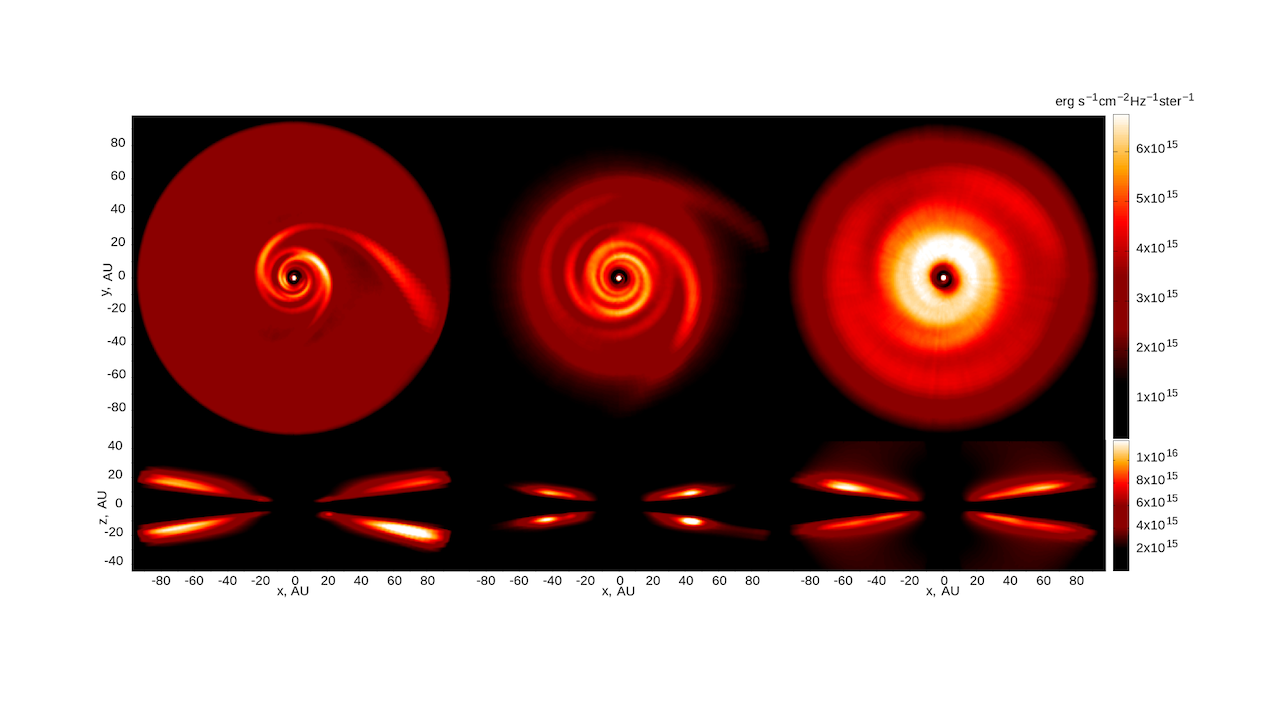The color shows the product of the radiation flux at a wavelength of 3 µm and the square of the distance for the case of a prograde fall of the planet onto the disk. Model parameters: q = 5 AU, ω = 90◦ , i = 10◦ . The time moment t = 200 years from the beginning of the calculations is shown on the left, t = 290 years is shown in the center, and t = 500 years is shown on the right. The upper graphs correspond to the direction of the line of sight against the z axis, and the lower ones along the y axis. — astro-ph.EP
Observational manifestations of disturbances in a protoplanetary disk caused by a collision with a massive planet are studied.
It is assumed that the planet moves along a parabolic trajectory that intersects the disk plane near the star. Gas-dynamic simulation is performed using the finite volume method on a long time scale. On its basis, images of the disk observed from the pole and edge-on are constructed in the infrared and submillimeter ranges.
A wide range of planet orbit parameters is considered. The approach of the planet was considered both prograde and retrograde with the respect to the disk rotation. Calculations have shown that in the images of the disk seen pole-on, two spiral arms can be observed in case of the prograde fall, and one with retrograde case.
In the case of observations of a disk whose plane is inclined at a small angle to the line of sight, distortions of the disk plane can be noticeable. In addition, a gas tail is extended from the disk in the direction of the planet’s motion, which can also be identified in observations.
Tatiana Demidova, Vitaliy Grigoryev
Comments: 26 pages, 9 figures, 1 table, 74 references
Subjects: Earth and Planetary Astrophysics (astro-ph.EP); Astrophysics of Galaxies (astro-ph.GA); Solar and Stellar Astrophysics (astro-ph.SR)
MSC classes: 85-04
ACM classes: J.2.3
Cite as: arXiv:2506.23795 [astro-ph.EP] (or arXiv:2506.23795v1 [astro-ph.EP] for this version)
https://doi.org/10.48550/arXiv.2506.23795
Focus to learn more
Journal reference: Astronomy Letters, 2024, Vol. 50, No. 10, pp. 625-637
Related DOI:
https://doi.org/10.1134/S1063773724700476
Focus to learn more
Submission history
From: Tatiana Demidova
[v1] Mon, 30 Jun 2025 12:37:19 UTC (2,433 KB)
https://arxiv.org/abs/2506.23795
Astrobiology,

